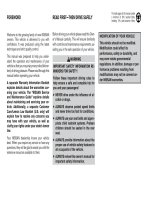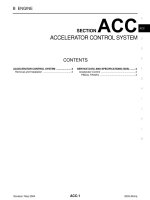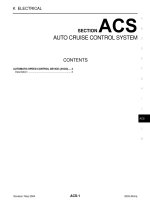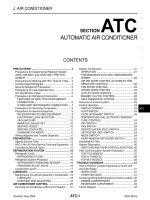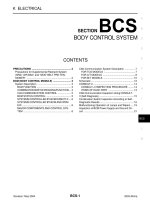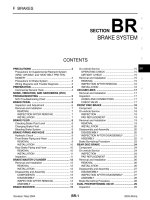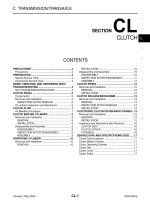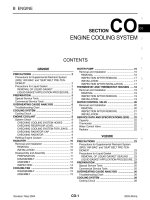SE hệ THỐNG GHẾ NGỒI NISSAN ALTIMA 2003
Bạn đang xem bản rút gọn của tài liệu. Xem và tải ngay bản đầy đủ của tài liệu tại đây (462.58 KB, 20 trang )
SE-1
SEAT
I BODY
CONTENTS
C
D
E
F
G
H
J
K
L
M
SECTION
A
B
SE
Revision: May 2004 2003 Altima
PRECAUTIONS 2
Precautions for Supplemental Restraint System
(SRS) “AIR BAG” and “SEAT BELT PRE-TEN-
SIONER” 2
Precautions for Work 2
PREPARATION 3
Special Service Tool 3
Commercial Service Tool 3
SQUEAK AND RATTLE TROUBLE DIAGNOSES 4
Work Flow 4
CUSTOMER INTERVIEW 4
DUPLICATE THE NOISE AND TEST DRIVE 5
CHECK RELATED SERVICE BULLETINS 5
LOCATE THE NOISE AND IDENTIFY THE
ROOT CAUSE 5
REPAIR THE CAUSE 5
CONFIRM THE REPAIR 6
Generic Squeak and Rattle Troubleshooting 6
INSTRUMENT PANEL 6
CENTER CONSOLE 6
DOORS 6
TRUNK 7
SUNROOF/HEADLINING 7
SEATS 7
UNDERHOOD 7
Diagnostic Worksheet 8
POWER SEAT 10
Wiring Diagram–SEAT– 10
HEATED SEAT 12
Description 12
Wiring Diagram–HSEAT– 13
FRONT SEAT 14
Removal and Installation 14
REMOVAL 15
INSTALLATION 15
Disassembly and Assembly 15
SEATBACK TRIM AND PAD 15
REMOVAL OF SEATBACK ASSEMBLY 16
INSTALLATION OF SEATBACK ASSEMBLY 16
SEAT CUSHION TRIM AND PAD 16
REAR SEAT 18
Removal and Installation 18
REMOVAL 18
INSTALLATION 18
Dissasembly and Assembly 18
SE-2
PRECAUTIONS
Revision: May 2004 2003 Altima
PRECAUTIONS PFP:00001
Precautions for Supplemental Restraint System (SRS) “AIR BAG” and “SEAT
BELT PRE-TENSIONER”
EIS001FI
The Supplemental Restraint System such as “AIR BAG” and “SEAT BELT PRE-TENSIONER”, used along
with a front seat belt, helps to reduce the risk or severity of injury to the driver and front passenger for certain
types of collision. This system includes seat belt switch inputs and dual stage front air bag modules. The SRS
system uses the seat belt switches to determine the front air bag deployment, and may only deploy one front
air bag, depending on the severity of a collision and whether the front occupants are belted or unbelted.
Information necessary to service the system safely is included in the SRS and SB section of this Service Man-
ual.
WARNING:
● To avoid rendering the SRS inoperative, which could increase the risk of personal injury or death
in the event of a collision which would result in air bag inflation, all maintenance must be per-
formed by an authorized NISSAN/INFINITI dealer.
● Improper maintenance, including incorrect removal and installation of the SRS, can lead to per-
sonal injury caused by unintentional activation of the system. For removal of Spiral Cable and Air
Bag Module, see the SRS section.
● Do not use electrical test equipment on any circuit related to the SRS unless instructed to in this
Service Manual. SRS wiring harnesses can be identified by yellow and/or orange harness connec-
tors.
Precautions for Work
EIS001D0
● When removing or disassembling each component, be careful not to damage or deform it. If a component
may be subject to interference, be sure to protect it with a shop cloth.
● When removing (disengaging) components with a screwdriver or similar tool, be sure to wrap the compo-
nent with a shop cloth or vinyl tape to protect it.
● Protect the removed parts with a shop cloth and keep them.
● Replace a deformed or damaged clip.
● If a part is specified as a non-reusable part, always replace it with new one.
● Be sure to tighten bolts and nuts securely to the specified torque.
● After re-installation is completed, be sure to check that each part works normally.
● Follow the steps below to clean components.
– Water soluble foul: Dip a soft cloth into lukewarm water, and wring the water out of the cloth to wipe the
fouled area.
Then rub with a soft and dry cloth.
– Oily foul: Dip a soft cloth into lukewarm water with mild detergent (concentration: within 2 to 3%), and wipe
the fouled area.
Then dip a cloth into fresh water, and wring the water out of the cloth to wipe the detergent off. Then rub
with a soft and dry cloth.
● Do not use organic solvent such as thinner, benzene, alcohol, or gasoline.
● For genuine leather seats, use a genuine leather seat cleaner.
PREPARATION
SE-3
C
D
E
F
G
H
J
K
L
M
A
B
SE
Revision: May 2004 2003 Altima
PREPARATION PFP:00002
Special Service Tool
EIS001D1
The actual shapes of Kent-Moore tools may differ from those of special service tools illustrated here.
Commercial Service Tool
EIS001D2
Tool number
(Kent-Moore No.)
Tool name
Description
(J-39570)
Chassis ear
Locating the noise
(J-43980)
NISSAN Squeak and Rattle
Kit
Repairing the cause of noise
SIIA0993E
SIIA0994E
Tool name Description
(J-39565)
Engine ear
Locating the noise
SIIA0995E
SE-4
SQUEAK AND RATTLE TROUBLE DIAGNOSES
Revision: May 2004 2003 Altima
SQUEAK AND RATTLE TROUBLE DIAGNOSES PFP:00000
Work Flow
EIS001D3
CUSTOMER INTERVIEW
Interview the customer if possible, to determine the conditions that exist when the noise occurs. Use the Diag-
nostic Worksheet during the interview to document the facts and conditions when the noise occurs and any
customer's comments; refer to SE-8, "
Diagnostic Worksheet" . This information is necessary to duplicate the
conditions that exist when the noise occurs.
● The customer may not be able to provide a detailed description or the location of the noise. Attempt to
obtain all the facts and conditions that exist when the noise occurs (or does not occur).
● If there is more than one noise in the vehicle, be sure to diagnose and repair the noise that the customer
is concerned about. This can be accomplished by test driving the vehicle with the customer.
● After identifying the type of noise, isolate the noise in terms of its characteristics.The noise characteristics
are provided so the customer, service adviser and technician are all speaking the same language when
defining the noise.
● Squeak —(Like tennis shoes on a clean floor)
Squeak characteristics include the light contact/fast movement/brought on by road conditions/hard sur-
faces=higher pitch noise/softer surfaces=lower pitch noises/edge to surface=chirping
● Creak—(Like walking on an old wooden floor)
Creak characteristics include firm contact/slow movement/twisting with a rotational movement/pitch
dependent on materials/often brought on by activity.
● Rattle—(Like shaking a baby rattle)
Rattle characteristics include the fast repeated contact/vibration or similar movement/loose parts/missing
clip or fastener/incorrect clearance.
● Knock —(Like a knock on a door)
Knock characteristics include hollow sounding/sometimes repeating/often brought on by driver action.
● Tick—(Like a clock second hand)
Tick characteristics include gentle contacting of light materials/loose components/can be caused by driver
action or road conditions.
● Thump—(Heavy, muffled knock noise)
Thump characteristics include softer knock/dead sound often brought on by activity.
● Buzz—(Like a bumble bee)
Buzz characteristics include high frequency rattle/firm contact.
● Often the degree of acceptable noise level will vary depending upon the person. A noise that you may
judge as acceptable may be very irritating to the customer.
● Weather conditions, especially humidity and temperature, may have a great affect on noise level.
SBT842
SQUEAK AND RATTLE TROUBLE DIAGNOSES
SE-5
C
D
E
F
G
H
J
K
L
M
A
B
SE
Revision: May 2004 2003 Altima
DUPLICATE THE NOISE AND TEST DRIVE
If possible, drive the vehicle with the customer until the noise is duplicated. Note any additional information on
the Diagnostic Worksheet regarding the conditions or location of the noise. This information can be used to
duplicate the same conditions when you confirm the repair.
If the noise can be duplicated easily during the test drive, to help identify the source of the noise, try to dupli-
cate the noise with the vehicle stopped by doing one or all of the following:
1) Close a door.
2) Tap or push/pull around the area where the noise appears to be coming from.
3) Rev the engine.
4) Use a floor jack to recreate vehicle "twist".
5) At idle, apply engine load (electrical load, half-clutch on M/T model, drive position on A/T model).
6) Raise the vehicle on a hoist and hit a tire with a rubber hammer.
● Drive the vehicle and attempt to duplicate the conditions the customer states exist when the noise occurs.
● If it is difficult to duplicate the noise, drive the vehicle slowly on an undulating or rough road to stress the
vehicle body.
CHECK RELATED SERVICE BULLETINS
After verifying the customer concern or symptom, check ASIST for Technical Service Bulletins (TSBs) related
to that concern or symptom.
If a TSB relates to the symptom, follow the procedure to repair the noise.
LOCATE THE NOISE AND IDENTIFY THE ROOT CAUSE
1. Narrow down the noise to a general area.To help pinpoint the source of the noise, use a listening tool
(Chassis Ear: J-39570, Engine Ear: J-39565 and mechanic's stethoscope).
2. Narrow down the noise to a more specific area and identify the cause of the noise by:
● removing the components in the area that you suspect the noise is coming from.
Do not use too much force when removing clips and fasteners, otherwise clips and fasteners can be bro-
ken or lost during the repair, resulting in the creation of new noise.
● tapping or pushing/pulling the component that you suspect is causing the noise.
Do not tap or push/pull the component with excessive force, otherwise the noise will be eliminated only
temporarily.
● feeling for a vibration with your hand by touching the component(s) that you suspect is (are) causing the
noise.
● placing a piece of paper between components that you suspect are causing the noise.
● looking for loose components and contact marks.
Refer to SE-6, "
Generic Squeak and Rattle Troubleshooting" .
REPAIR THE CAUSE
● If the cause is a loose component, tighten the component securely.
● If the cause is insufficient clearance between components:
– separate components by repositioning or loosening and retightening the component, if possible.
– insulate components with a suitable insulator such as urethane pads, foam blocks, felt cloth tape or ure-
thane tape. A NISSAN Squeak and Rattle Kit (J-43980) is available through your authorized Nissan Parts
Department.
CAUTION:
Do not use excessive force as many components are constructed of plastic and may be damaged.
Always check with the Parts Department for the latest parts information.
The following materials are contained in the NISSAN Squeak and Rattle Kit (J-43980). Each item can be
ordered separately as needed.
URETHANE PADS [1.5 mm (0.059 in) thick]
Insulates connectors, harness, etc.
76268-9E005: 100×135 mm (3.94×5.31 in)/76884-71L01: 60×85 mm (2.36×3.35 in)/76884-71L02:
15×25mm(0.59×0.98 in)
INSULATOR (Foam blocks)
Insulates components from contact.Can be used to fill space behind a panel.
73982-9E000: 45 mm (1.77 in) thick, 50×50 mm (1.97×1.97 in)/73982-50Y00: 10 mm (0.39 in) thick,
50×50 mm (1.97×1.97 in)
INSULATOR (Light foam block)
SE-6
SQUEAK AND RATTLE TROUBLE DIAGNOSES
Revision: May 2004 2003 Altima
80845-71L00: 30 mm (1.18 in) thick, 30×50 mm (1.18×1.97 in)
FELT CLOTHTAPE
Used to insulate where movement does not occur.Ideal for instrument panel applications.
68370-4B000: 15×25 mm (0.59×0.98 in) pad/68239-13E00: 5 mm (0.20 in) wide tape roll. The following mate-
rials, not found in the kit can also be used to repair squeaks and rattles.
UHMW (TEFLON) TAPE
Insulates where slight movement is present. Ideal for instrument panel applications.
SILICONE GREASE
Used in place of UHMW tape that will be visible or not fit.
Note: Will only last a few months.
SILICONE SPRAY
Use when grease cannot be applied.
DUCT TAPE
Use to eliminate movement.
CONFIRM THE REPAIR
Confirm that the cause of a noise is repaired by test driving the vehicle. Operate the vehicle under the same
conditions as when the noise originally occurred. Refer to the notes on the Diagnostic Worksheet.
Generic Squeak and Rattle Troubleshooting
EIS001D4
Refer to Table of Contents for specific component removal and installation information.
INSTRUMENT PANEL
Most incidents are caused by contact and movement between:
1. The cluster lid A and instrument panel
2. Acrylic lens and combination meter housing
3. Instrument panel to front pillar garnish
4. Instrument panel to windshield
5. Instrument panel mounting pins
6. Wiring harnesses behind the combination meter
7. A/C defroster duct and duct joint
These incidents can usually be located by tapping or moving the components to duplicate the noise or by
pressing on the components while driving to stop the noise. Most of these incidents can be repaired by apply-
ing felt cloth tape or silicone spray (in hard to reach areas). Urethane pads can be used to insulate wiring har-
ness.
CAUTION:
Do not use silicone spray to isolate a squeak or rattle. If you saturate the area with silicone, you will
not be able to recheck the repair.
CENTER CONSOLE
Components to pay attention to include:
1. Shifter assembly cover to finisher
2. A/C control unit and cluster lid C
3. Wiring harnesses behind audio and A/C control unit
The instrument panel repair and isolation procedures also apply to the center console.
DOORS
Pay attention to the:
1. Finisher and inner panel making a slapping noise
2. Inside handle escutcheon to door finisher
3. Wiring harnesses tapping
4. Door striker out of alignment causing a popping noise on starts and stops
Tapping or moving the components or pressing on them while driving to duplicate the conditions can isolate
many of these incidents. You can usually insulate the areas with felt cloth tape or insulator foam blocks from
the NISSAN Squeak and Rattle Kit (J-43980) to repair the noise.
SQUEAK AND RATTLE TROUBLE DIAGNOSES
SE-7
C
D
E
F
G
H
J
K
L
M
A
B
SE
Revision: May 2004 2003 Altima
TRUNK
Trunk noises are often caused by a loose jack or loose items put into the trunk by the owner.
In addition look for:
1. Trunk lid bumpers out of adjustment
2. Trunk lid striker out of adjustment
3. The trunk lid torsion bars knocking together
4. A loose license plate or bracket
Most of these incidents can be repaired by adjusting, securing or insulating the item(s) or component(s) caus-
ing the noise.
SUNROOF/HEADLINING
Noises in the sunroof/headlining area can often be traced to one of the following:
1. Sunroof lid, rail, linkage or seals making a rattle or light knocking noise
2. Sunvisor shaft shaking in the holder
3. Front or rear windshield touching headlining and squeaking
Again, pressing on the components to stop the noise while duplicating the conditions can isolate most of these
incidents. Repairs usually consist of insulating with felt cloth tape.
SEATS
When isolating seat noise it is important to note the position the seat is in and the load placed on the seat
when the noise is present. These conditions should be duplicated when verifying and isolating the cause of
the noise.
Cause of seat noise include:
1. Headrest rods and holder
2. A squeak between the seat pad cushion and frame
3. The rear seatback lock and bracket
These noises can be isolated by moving or pressing on the suspected components while duplicating the con-
ditions under which the noise occurs. Most of these incidents can be repaired by repositioning the component
or applying urethane tape to the contact area.
UNDERHOOD
Some interior noise may be caused by components under the hood or on the engine wall. The noise is then
transmitted into the passenger compartment.
Causes of transmitted underhood noise include:
1. Any component mounted to the engine wall
2. Components that pass through the engine wall
3. Engine wall mounts and connectors
4. Loose radiator mounting pins
5. Hood bumpers out of adjustment
6. Hood striker out of adjustment
These noise can be difficult to isolate since they cannot be reached from the interior of the vehicle. The best
method is to secure, move or insulate one component at a time and test drive the vehicle. Also, engine RPM
or load can be changed to isolate the noise. Repairs can usually be made by moving, adjusting securing, or
insulating the component causing the noise.
SE-8
SQUEAK AND RATTLE TROUBLE DIAGNOSES
Revision: May 2004 2003 Altima
Diagnostic Worksheet
EIS001D5
SBT843
SQUEAK AND RATTLE TROUBLE DIAGNOSES
SE-9
C
D
E
F
G
H
J
K
L
M
A
B
SE
Revision: May 2004 2003 Altima
SBT844
SE-10
POWER SEAT
Revision: May 2004 2003 Altima
POWER SEAT PFP:87016
Wiring Diagram–SEAT–
EIS001D6
WIWA0052E
POWER SEAT
SE-11
C
D
E
F
G
H
J
K
L
M
A
B
SE
Revision: May 2004 2003 Altima
TERMINALS AND REFERENCE VALUE MEASURED BETWEEN EACH TERMINAL AND GROUND
TERMINAL WIRE COLOR ITEM CONDITION DATA (DC)
7 W/B BATTERY POWER — 12V
9 W/G POWER SEAT SWITCH
OFF 12V
ON 12V
SE-12
HEATED SEAT
Revision: May 2004 2003 Altima
HEATED SEAT PFP:87335
Description
EIS001D7
● When handling seat, be extremely careful not to scratch heating unit.
● To replace heating unit, seat trim and pad should be separated.
● Do not use any organic solvent, such as thinner, benzene, alcohol, etc. to clean trim.
WIIA0031E
HEATED SEAT
SE-13
C
D
E
F
G
H
J
K
L
M
A
B
SE
Revision: May 2004 2003 Altima
Wiring Diagram–HSEAT–
EIS001D8
WIWA0053E
SE-14
FRONT SEAT
Revision: May 2004 2003 Altima
FRONT SEAT PFP:87000
Removal and Installation
EIS001D9
1. Seat lumbar unit lever 2. Seatback trim 3. Seatback pad
4. Headrest holder (free) 5. Seatback frame 6. Seatback board
7. Seatback heater unit 8. Headrest holder (locked) 9. Seat cushion trim
10
.
Seat cushion heater unit 11
.
Seat cushion pad 12
.
Silk film bag
WIIA0032E
FRONT SEAT
SE-15
C
D
E
F
G
H
J
K
L
M
A
B
SE
Revision: May 2004 2003 Altima
REMOVAL
When removing or installing the seat trim, handle it carefully to keep dirt out and avoid damage.
CAUTION:
● Before removing the front seat, turn the ignition switch off, disconnect both battery cables and
wait and least 3 minutes.
● When checking the power seat circuit for continuity using a circuit tester, do not confuse its con-
nector with the side air bag module connector. Such an error may cause the air bag to deploy.
● Do not drop, tilt, or bump the side air bag module while installing the seat. Always handle it with
care.
● After front side air bag module inflates, front seatback assembly must be replaced.
1. Slide the seat until the four body mounting bolts are visible and a tool can be inserted.
NOTE:
● When disassembling the driver seat after removal, set the front/rear cushion lifter to the top position.
2. Disconnect both battery cables and wait at least 3 minutes.
3. Remove the harness connector for the side air bag module.
4. Remove the four body mounting bolts and the seat belt anchor bolt.
To remove the seat belt anchor bolt, refer to SB-4, "
Removal and Installation of Front Seat Belt" .
5. Remove the power seat harness connector and vehicle harness fixing clip from the vehicle.
NOTE:
When removing and installing, use shop cloths to protect the parts from damage where they may interfere
with other parts.
INSTALLATION
● Install in the reverse order of removal.
NOTE:
Be sure to insert the rear end tab of the rear leg cover under the rail.
Disassembly and Assembly
EIS001DA
SEATBACK TRIM AND PAD
WARNING:
Removal of front side air bag module should only be done to allow deployment of front side air bag
module prior to disposal of seatback assembly.
NOTE:
Only complete seatback assemblies can be replaced on vehicles equipped with side air bags.
NOTE:
Be sure to set the front/rear cushion lifter to the top position.
1. Remove the seatback board from the back of the seatback.
13
.
Seat cushion frame 14
.
Seat cushion inner finisher 15
.
Driver seat frame assembly
16
.
Seat cushion front finisher 17
.
Power seat switch 18
.
Slide-lifter switch knob
19
.
Reclining switch knob 20
.
Seat cushion outer finisher 21
.
Driver power seat harness
PIIA0163E
SE-16
FRONT SEAT
Revision: May 2004 2003 Altima
2. From the back of the seatback, press the headrest holder tabs at
the base of the stay pipe to disengage. Then pull the headrest
holder up to remove.
NOTE:
Before installing the headrest holder, check its orientation (front/
rear and right/left).
3. Remove the retainer.
4. Remove the seat heater harness connector. After removing the seatback trim and pad, remove the hog
ring to separate the trim from the pad and the seatback heater unit.
REMOVAL OF SEATBACK ASSEMBLY
1. After completing the steps 1 and 2 of "Seatback Trim and Pad", remove the harness connectors for the
reclining motor and lumbar support motor (driver seat only).
2. Pull out the harness connector for the side air bag from the seat cushion.
3. Remove the reclining device mounting bolts (2 for each side) on the seatback frame, and remove the
seatback assembly.
NOTE:
When assembling the seatback frame, make sure that the reclining device is locked on both sides, and be
sure to temporarily tighten the bolts, then finish tightening them.
INSTALLATION OF SEATBACK ASSEMBLY
● Install in the reverse order of removal.
SEAT CUSHION TRIM AND PAD
1. Remove the power seat switch knob (or recline knob on manual seat).
2. Remove the front seat cushion finisher (inner).
3. Remove the three power seat switch assembly screws (or lift knobs on manual seats).
LRS023
SIIA0113E
WIIA0033E
FRONT SEAT
SE-17
C
D
E
F
G
H
J
K
L
M
A
B
SE
Revision: May 2004 2003 Altima
4. Remove four bolts retaining the seat cushion assembly, remove
seat cushion assembly.
5. Remove the retainer on the seat cushion frame, then remove the harness connector for the seat heater.
6. After removing the seat cushion trim and pad, remove the hog rings to separate the trim from the pad and
seat cushion heater unit.
SIIA0503E
SE-18
REAR SEAT
Revision: May 2004 2003 Altima
REAR SEAT PFP:88300
Removal and Installation
EIS001DC
REMOVAL
1. Pull the lock at the front bottom of the seat cushion forward (1
for each side), and pull the seat cushion upward to release the
wire from the plastic hook, then pull the seat cushion forward to
remove.
2. Remove the RH and LH screws on the seatback.
3. Slide the seatback upward to pull off the wire from the wire from
the vehicle-side hook, and remove the seatback.
4. After removing, remove the hog ring to separate the trim and
pad.
INSTALLATION
● Install in the reverse order of removal.
Dissasembly and Assembly
EIS001DB
SIIA0511E
1. Rear seat side bolster assembly 2. Passenger seatback trim and pad 3. Driver seatback trim and pad
4. Rear seatback hinge assembly 5. Rear seat cushion trim and pad 6. Rear seat armrest
WIIA0034E
REAR SEAT
SE-19
C
D
E
F
G
H
J
K
L
M
A
B
SE
Revision: May 2004 2003 Altima
Center Seatback Assembly
WIIA0035E
1. Passenger seatback trim and pad 2. Rear seat armrest 3. Cup holder bracket
4. Cup holder 5. Cup holder retaining screws/covers
SE-20
REAR SEAT
Revision: May 2004 2003 Altima
